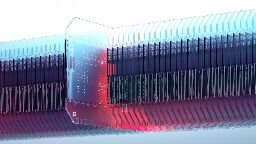Video of ceramic storage system prototype surfaces online — 10,000TB cartridges bombarded with laser rays could become mainstream by 2030, making slow hard drives and tapes obsolete



techradar.com
Video of ceramic storage system prototype surfaces online — 10,000TB cartridges bombarded with laser rays could become mainstream by 2030, making slow hard drives and tapes obsolete::Ceramics-based storage medium consumes very little energy and lasts more than 5,000 years, creators say
You are viewing a single comment
Just wait until one of your techs drops a cassette of these glass and ceramic plates and suddenly your company is out 100,000TB of data.
The whole "it can last 5000 years" thing is somewhat ridiculous considering the library mechanisms, carriers for the slides and basically everything else not glass and ceramic probably won't last more than 20 or 30.
It is possible to make glass and ceramics that are resistant to shattering from fair hard impacts. I don't know if that can be employed here, but there are other ways to deal with the problem.
Additionally, if 100,000 TB is something that people can carry by hand, then it is also possible to back up those drives relatively easily (relative to that technology).
Lastly, current silicon fabs have boxes of wafers that at the final stages can exceed $1M in the retail value. They have robots that handle those. If the 100,000 TB is worth something close to that, then a human will not be carrying it.
You're not playing Lemmy correctly. The highest rated post must always be a half-hearted pessimistic lazy criticism of whatever new technology is being described.
Who dat
Pharma has entered the chat...they just have warehouse people riding forklifts with pallets worth much more than $1M.
I'm sure pharmacy has some crazy value density, but it's hards to put accurate values on their products because of insurance.
The boxes of wafers I was talking about is roughly 1.5 ft cubed. The fabs will have hundreds of these boxes moving around by robots at any one time.
Not really, i work in the industry (in europe), and prices we use in the production facilities are actual selling value, not the ridicolous inflated prices you see on the invoice in the US.
Or just put the cartridge in a shockproof box. One that can last as long as the medium. It can't be that hard to make a really good box.
As far as I know, there is 1 storage technology that has survived wars. Paper.
Say that to the library of Alexandria.
Yes, but paper isn't information dense and is highly susceptible to even the smallest amount of moisture in the air.
Paper is notoriously easy to destroy in conflicts
There's another, better one: stone carvings.
That’s… literally always a concern. Name a digital storage medium impervious to impact damage. You can’t.
Isn't that a concern with other tech too? If storage is cheaper, it would enable for more redundant copies
A lot of places just don't have backups. I'm thinking of hospitals getting hit with ransomware attacks, some are fine and just pull from backups and others shell out lots of money.
I'd love to see cheaper enterprise storage since it'll be easier to justify more backups. That single IT guy managing a hospital network could use a break...
Having backups at multiple sites is industry standard. Nobody is keeping 100,000TB of data in a single location.
As for your second point, I don't see the relevance. You can store the glass wherever you want, the other mechanisms aren't relevant for keeping the stored data.
But ceramic plates can probably be put into a working enclosure to get the data from it again
Just like how if you put a shattered CD in an apparatus, you can still use a laser reader to recover any data on the undamaged sections.
Though, because data is recorded in a circular pattern at high speeds, you won't get much. Or what you get will have lots of corruption. I wonder what pattern of storage these plates use? If it's similar to SSDs, then large files can be nested in a very small area of space - increasing the chances of recovery.
They have a video on their channel showing them bending and twisting the material.